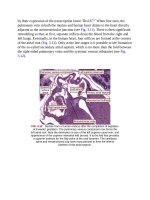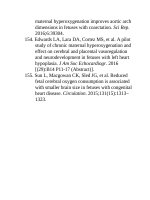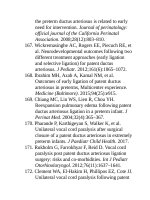Andersons pediatric cardiology 1115
Bạn đang xem bản rút gọn của tài liệu. Xem và tải ngay bản đầy đủ của tài liệu tại đây (127.12 KB, 3 trang )
FIG.42.14 Two-dimensionalimageintheparasternalshort-axisview
showsdiscretestenosisinthesubvalvarregionofthepulmonicvalve.
FIG.42.15 Color-comparisonimagesintheparasternalshort-axisview
obtainedfromapatientwithsupravalvarpulmonicstenosis.(A)Twodimensionalimagedemonstratingdiscretenarrowingofthemain
pulmonaryarteryinthesupravalvarregionofthepulmonicvalve.(B)ColorflowDopplerimagedemonstratingflowturbulenceoriginatinginthe
supravalvarregionandcorrespondingwiththesiteofstenosisseenonthe
left-sidedtwo-dimensionalimage.
FIG.42.16 Parasternalshort-axisviewdemonstratingpoststenoticdilation
ofthepulmonarytrunk.
FIG.42.17 Thediameterofthepulmonaryvalveatthehemodynamic
ventriculoarterialjunctioncanbemeasuredaccuratelywith
echocardiographytoaidininterventionplanning.
Distaltothevalve,itispossibletoidentifystenosiswithintheproximal
pulmonaryarterialtree,althoughotherformsofimagingarenecessarytoassess
pulmonaryarterialpathologydistaltothebifurcation.Thepresenceofadditional
abnormalities,suchasatrialseptaldefects,canberecorded.
Three-dimensionalechocardiographyisbeingusedmorefrequentlyinthe
imagingofcongenitalheartdefectsduetoitsabilitytoprovidemoredetailed
noninvasiveimagingoftheseanomalies.Specifically,withregardtopulmonic
valvestenosis,three-dimensionalechocardiographymayprovidebetter
visualizationofthemorphologyandfunctionofthepulmonicvalve.30Although
itenhancesvisualizationofthemorphologicfeaturesofthepulmonicvalve,itis
uncommonthatthree-dimensionalechocardiographyyieldsadditional
informationaffectingclinicalmanagementinpulmonaryvalvestenosisover
traditionalmethods,suchascolor-flowandDopplergradientassessment.
Previously,ECGwasthemainstayofnoninvasiveassessmentoftheseverity
ofpulmonaryvalvestenosisdespiteECGcorrelatesofrightventricular
hypertrophybeingrelativelyweak.SincetheadventofDoppler
echocardiography,assessmentisgreatlysimplified.Color-flowDopplershows
turbulentbloodoriginatingatthepointofstenosis(Fig.42.18;Videos42.2and
42.3).Bothpulsedandcontinuous-waveinterrogationspermitmeasurementof
themaximalvelocityoftheflowacrossthestenosis(Fig.42.19).Thepressure
gradientcanbeestimatedmoreaccuratelyusingthemodifiedandsimplified
Bernoulliequation,wherethevalvarpressuregradient,expressedinmillimeters
ofmercuryorΔP,iscalculatedfromthemaximalDopplervelocityatmetersper
second,orV,acrossthepulmonaryvalve:









